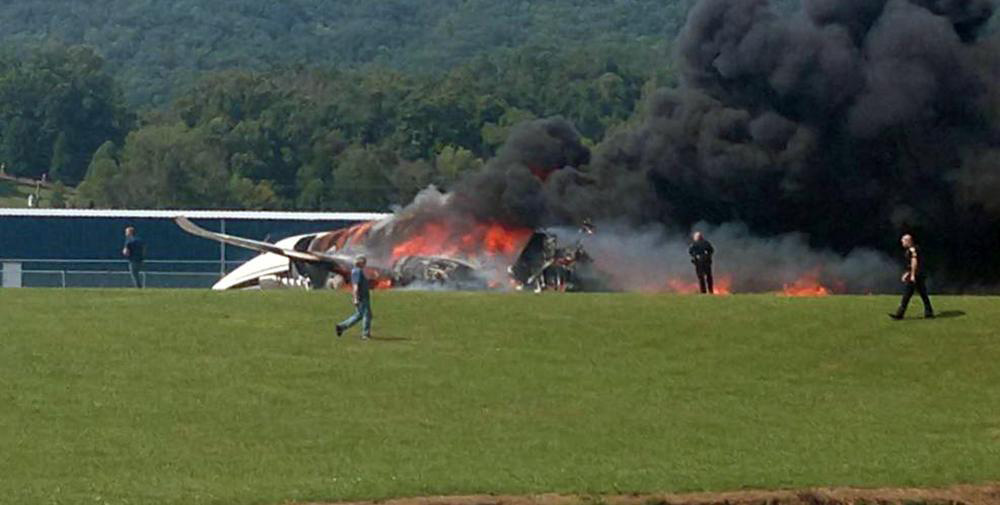Passenger Briefings (Passenger Training)
Pre-flight briefings often end up treated as a necessary evil to many experienced aviators and passengers. However, this requirement serves an extremely important part of keeping aviation a safe form of travel. Regardless of how you treat your pre-flight briefings, or your opinion of their effectiveness, we set the standard at:
- Thorough enough to ensure your passengers end up with the knowledge necessary to save themselves without your assistance – which includes opening the main A/C door.
- And, with you unconscious or incapacitated, their ability to save you.

Aug 15, 2019, Cessna Citation Latitude, Dale Earnhardt, Jr & Family – Elizabethton, TN NTSB Report - ERA19FA248
Image from the very extensive Kathryn’s Report on August 15, 2019.
There are Two Types of Briefings
First, prior to takeoff. Here are the basic requirements:

FAR PART 91.519 REQUIREments
Click HerePart 91 considerations

FAR PART 135.117 REQUIREMENTS
Click HerePart 135 considerations
Briefing Cards - an Important Safety Tool
ADDITIONALLY, A PICTORIAL BRIEFING CARD MUST BE AVAILABLE FOR EVERY PASSENGER AND IT MUST ACCURATELY DEPICT THE LOCATION AND USE OF THE AIRCRAFT’S EMERGENCY EQUIPMENT AND GEAR. IF YOU CHANGE THE TYPE OR LOCATION OF A PIECE OF SAFETY EQUIPMENT, IT IS IMPORTANT TO UPDATE ALL YOUR BRIEFING CARDS TO REFLECT THE CHANGES.
There are Two Types of Briefings
The second type of briefing occurs when a crewmember briefs (trains) the passengers on what to expect, in real time, during an emergency.
For example, an inflight fire, loss of cabin pressure, or off-field landing. Not surprisingly, passengers usually listen to these briefings very carefully. Always deliver emergency briefings in a calm and clear manner because the emotion and/or anxiety you show, positive or negative, is contagious.
After a very thorough analysis of US Air Flt 1549, the Hudson River Ditching in 2009, the NTSB suggests (Safety Recommendation A-10-63 through-86) companies should try to become more creative and therefore effective, when delivering their briefings. Unfortunately, most passengers pay little attention to pre-flight safety briefings, let alone study, or even look at the briefing cards. Passengers often ignore these briefs because they feel they already know the information. For more information on the conclusions and investigation of the NTSB’s 2010 US Air 1549 Accident click here.
Several large commercial carriers have produced creative briefings illustrating neat ways to attract and keep the attention of the passengers onboard. These videos use humor, pop-culture, music, and even cartoons to convey required information. Keep these examples in mind and try to make a connection to your passengers to convey this vital and potentially life-saving information. The passengers will follow your lead in taking the material seriously which then directly translates to performance in an emergency.
Japan Airlines (2019)
Video Game Applications - Serious Games
“Serious” games represent a topic of research which looks at the efficacy of interactive applications, combining aspects of education and entertainment for the transmission and retention of safety information. Since 2013, the FAA’s Cabin Safety Research Team continues to collaborate, via grants and correspondence, with the Human Computer Interaction Lab at the University of Udine, Italy. This collaboration led to the development and successful deployment of multiple, freely available applications for aviation passenger safety. Find these applications free on Facebook or the mobile app stores from Google and Apple:
- HCI Lab, Udine Applications
- Plane Troubles
- Life Vest, Learn to Brace, and Prepare for Impact are also on the site.
- Udine’s - Other Creative Apps
